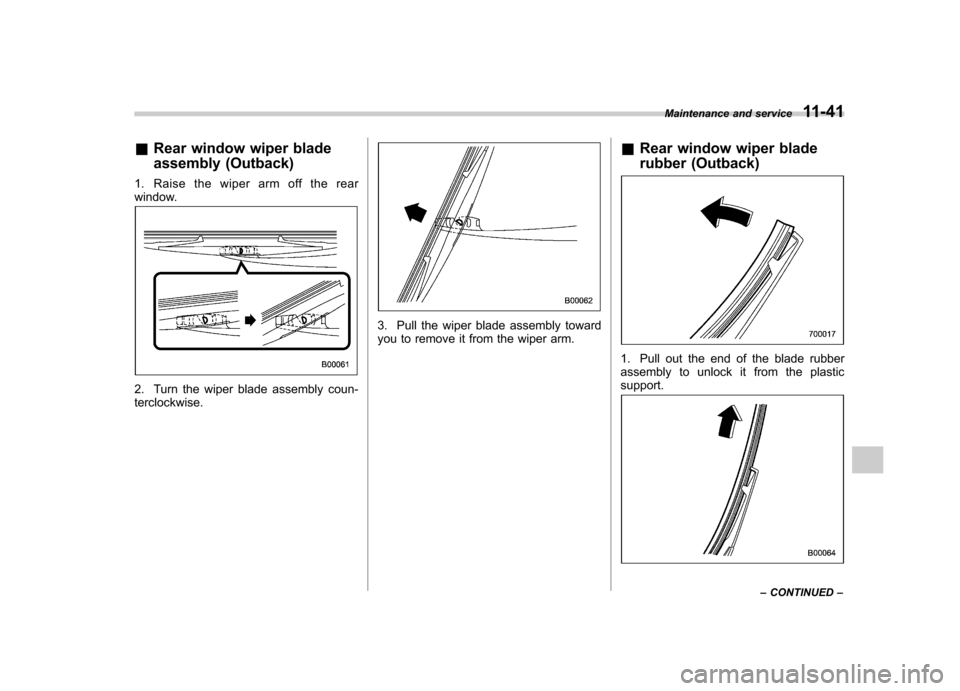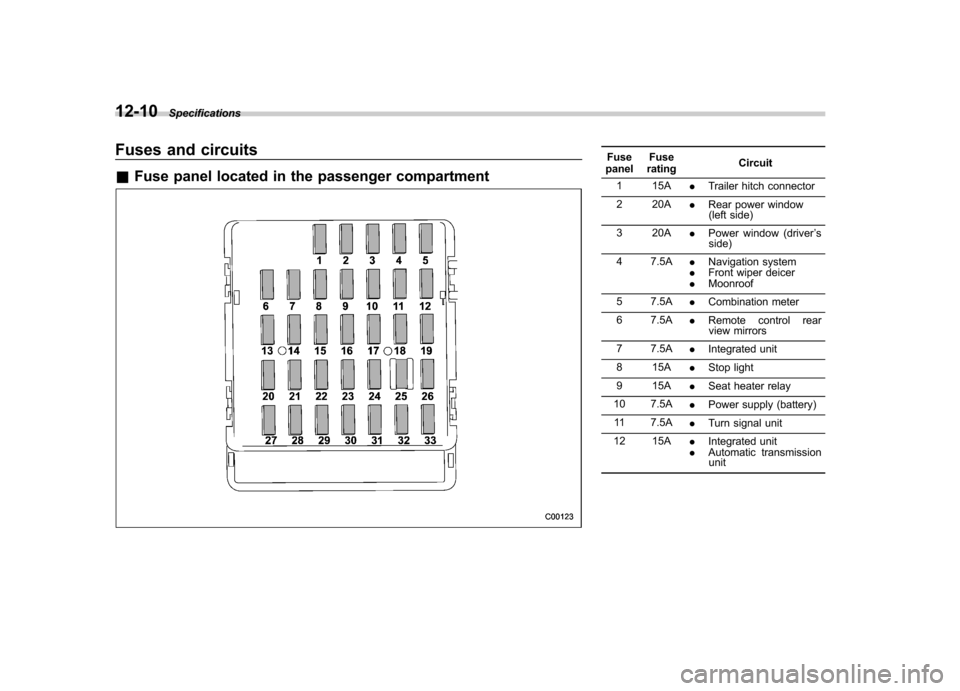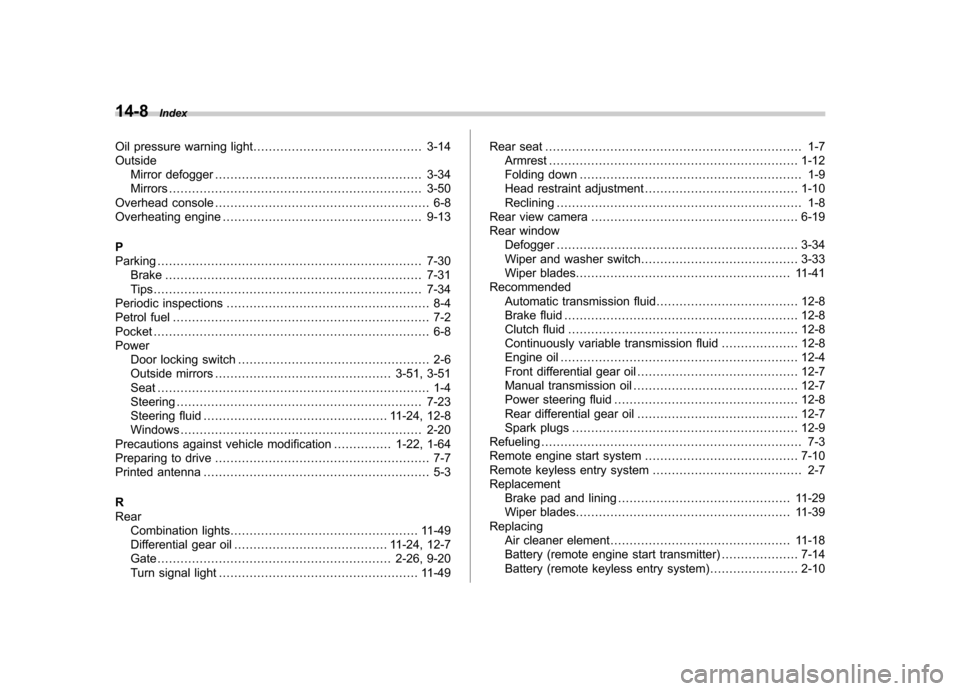2012 SUBARU OUTBACK window
[x] Cancel search: windowPage 410 of 474

Replacement of wiper blades
Grease, wax, insects, or other materials
on the windshield or the wiper blade
results in jerky wiper operation and streak-
ing on the glass. If you cannot remove the
streaks after operating the windshield
washer or if the wiper operation is jerky,
clean the outer surface of the windshield
(or rear window) and the wiper blades
using a sponge or soft cloth with a neutral
detergent or mild abrasive cleaner. After
cleaning, rinse the windshield and wiper
blades with clean water. The windshield is
clean if beads do not form when you rinse
the windshield with water.
CAUTION
. Do not clean the wiper blades
with gasoline or a solvent, such
as paint thinner or benzine. This
will cause deterioration of the
wiper blades.
. Whenyouwishtoraisethe
passenger-side wiper arm, first
raise the driver-side wiper arm.
Otherwise, the passenger-side
wiper assembly and driver-side
wiper assembly will touch each
other, possibly resulting inscratches. .
Return the passenger-side wiper
arm to its original position before
returning the driver-side wiper
arm to its original position.
Otherwise, the passenger-side
wiper assembly and driver-side
wiper assembly will touch each
other, possibly resulting inscratches.
. When returning the raised wipers
to the original positions, return
the wipers slowly on the wind-
shield by hand. Returning the
wipers from the detached posi-
tions by the spring operation
might change the shape of the
wiper arm or scratch the wind-shield.
If you cannot eliminate the streaking even
after following this method, replace the
wiper blades using the following proce-dures. &
Windshield wiper blade as- sembly
1. Raise the wiper arm off the windshield.1) Open the cover
2) Pull down the wiper blade
2. Remove the wiper blade assembly by
opening the cover and pulling it down in
the direction shown in the illustration.
3. Install the wiper blade assembly to the
wiper arm. Make sure that it locks in place.
4. Hold the wiper arm by hand and slowly
lower it in position. Maintenance and service
11-39
– CONTINUED –
Page 412 of 474

&Rear window wiper blade
assembly (Outback)
1. Raise the wiper arm off the rear
window.
2. Turn the wiper blade assembly coun- terclockwise.
3. Pull the wiper blade assembly toward
you to remove it from the wiper arm. &
Rear window wiper blade
rubber (Outback)
1. Pull out the end of the blade rubber
assembly to unlock it from the plasticsupport.
Maintenance and service 11-41
– CONTINUED –
Page 413 of 474

11-42Maintenance and service
2. Pull the blade rubber assembly out of
the plastic support.
1) Metal spines
3. If the new blade rubber is not provided
with two metal spines, remove the metal
spines from the old blade rubber and
install them in the new blade rubber.
4. Align the claws of the plastic support
with the grooves in the blade rubber
assembly, then slide the blade rubber
assembly into place.
Securely retain both ends of the rubber
with the stoppers on the plastic support ends. If the rubber is not retained properly,
the wiper may scratch the rear windowglass.
5. Install the wiper blade assembly to the
wiper arm. Make sure that it locks in place.
6. Hold the wiper arm by hand and slowly
lower it in position.
Page 437 of 474

12-10Specifications
Fuses and circuits &Fuse panel located in the passenger compartmentFuse
panel Fuse
rating Circuit
1 15A .Trailer hitch connector
2 20A .Rear power window
(left side)
3 20A .Power window (driver ’s
side)
4 7.5A .Navigation system
. Front wiper deicer
. Moonroof
5 7.5A .Combination meter
6 7.5A .Remote control rear
view mirrors
7 7.5A .Integrated unit
8 15A .Stop light
9 15A .Seat heater relay
10 7.5A .Power supply (battery)
11 7.5A .Turn signal unit
12 15A .Integrated unit
. Automatic transmission
unit
Page 438 of 474

Fuse
panel Fuse
rating Circuit
13 20A .Socket
14 Empty
15 20A .Rear power window
(right side)
16 Empty
17 15A .Front wiper deicer
18 7.5A .Back-up light
19 7.5A .Electronic parking
brake unit
. Hill Holder system unit
20 10A .Accessory power outlet
21 7.5A .Starter relay
22 15A .Air conditioner
23 Empty
24 15A .Audio
. Navigation system
25 15A .SRS airbag system
26 7.5A .Main fan
27 30A .Power window relay Fuse
panel Fuse
rating Circuit
28 Empty
29 20A .Power window
(passenger ’s side)
30 Empty
31 7.5A .Automatic air condi-
tioner unit
32 Empty
33 7.5A .ABS/Vehicle dynamics
control unit
. Power steering Specifications
12-11
– CONTINUED –
Page 440 of 474

Fuse
panel Fuse
rating Circuit
13 15A .Engine control unit
14 15A .Ignition coil
15 15A .Engine control unit
16 15A .Engine control unit
17 15A .Automatic transmission
control unit
18 10A .Illumination
19 10A .Rear combination light
20 15A .Turn and hazard warn-
ing flasher (body control unit)
21 20A .Door lock (body control
unit)
22 15A .Rear wiper
. Rear washer
23 10A .Front washer
24 30A .Front wiper
25 25A .Rear window defogger
. Mirror heater
. Front wiper deicer
26 15A .Blower fan
27 15A .Blower fan Fuse
panel Fuse
rating Circuit
28 25A .Audio unit
29 25A .Sub fan
30 25A .Main fan
31 30A .ABS/Vehicle dynamics
control unit
32 10A .Fog light (right side)
33 10A .Fog light (left side)
34 10A .Back-up (body control
unit) Specifications
12-13
Page 450 of 474

The vehicle placard shows original
tire size, recommended cold tire
inflation pressure on each tire at
maximum loaded vehicle weight,
seating capacity and loading infor-mation. !Adverse safety consequences
of under-inflation
Driving at high speeds with exces-
sively low tire pressures can cause
the tires to flex severely and to
rapidly become hot. A sharp in-
crease in temperature could cause
tread separation, and failure of the
tire(s). Possible resulting loss of
vehicle control could lead to anaccident. ! Measuring and adjusting air
pressure to achieve proper in-
flation
Check and, if necessary, adjust the
pressure of each tire (including the
spare) at least once a month and
before any long journey. Check the
tire pressures when the tires are
cold. Use a pressure gauge to
adjust the tire pressures to the specific values. Driving even a
short distance warms up the tires
and increases the tire pressures.
Also, the tire pressures are affected
by the outside temperature. It is
best to check tire pressure out-
doors before driving the vehicle.
When a tire becomes warm, the air
inside it expands, causing the tire
pressure to increase. Be careful not
to mistakenly release air from a
warm tire to reduce its pressure.
& Glossary of tire terminology
. Accessory weight
The combined weight (in excess of
those standard items which may be
replaced) of automatic transmis-
sion, power steering, power brakes,
power windows, power seats, radio,
and heater, to the extent that these
items are available as factory-in-
stalled equipment (whether in-
stalled or not). . Bead
The part of the tire that is made of
steel wires, wrapped or reinforced by ply cords and that is shaped to fit
the rim. .
Bead separation
A breakdown of the bond between
components in the bead.. Bias ply tire
A pneumatic tire in which the ply
cords that extend to the beads are
laid at alternate angles substantially
less than 90 degrees to the center-
line of the tread. . Carcass
The tire structure, except tread and
sidewall rubber which, when in-
flated, bears the load.. Chunking
The breaking away of pieces of the
tread or sidewall.. Cold tire pressure
The pressure in a tire that has been
driven less than 1 mile or has been
standing for three hours or more.. Cord
The strands forming the plies in thetire.. Cord separation
The parting of cords from adjacent
Consumer information and Reporting safety defects
13-5
– CONTINUED –
Page 469 of 474

14-8Index
Oil pressure warning light ............................................ 3-14
Outside Mirror defogger ...................................................... 3-34
Mirrors .................................................................. 3-50
Overhead console ........................................................ 6-8
Overheating engine .................................................... 9-13
P Parking ..................................................................... 7-30
Brake ................................................................... 7-31
Tips...................................................................... 7-34
Periodic inspections ..................................................... 8-4
Petrol fuel ................................................................... 7-2
Pocket ........................................................................ 6-8
Power Door locking switch .................................................. 2-6
Outside mirrors .............................................. 3-51, 3-51
Seat ....................................................................... 1-4
Steering ................................................................ 7-23
Steering fluid ................................................ 11-24, 12-8
Windows ............................................................... 2-20
Precautions against vehicle modification ............... 1-22, 1-64
Preparing to drive ........................................................ 7-7
Printed antenna ........................................................... 5-3
R Rear Combination lights ................................................. 11-49
Differential gear oil ........................................ 11-24, 12-7
Gate ............................................................. 2-26, 9-20
Turn signal light .................................................... 11-49 Rear seat
................................................................... 1-7
Armrest ................................................................. 1-12
Folding down .......................................................... 1-9
Head restraint adjustment ........................................ 1-10
Reclining ................................................................ 1-8
Rear view camera ...................................................... 6-19
Rear window
Defogger ............................................................... 3-34
Wiper and washer switch ......................................... 3-33
Wiper blades ........................................................ 11-41
Recommended Automatic transmission fluid ..................................... 12-8
Brake fluid ............................................................. 12-8
Clutch fluid ............................................................ 12-8
Continuously variable transmission fluid .................... 12-8
Engine oil .............................................................. 12-4
Front differential gear oil .......................................... 12-7
Manual transmission oil ........................................... 12-7
Power steering fluid ................................................ 12-8
Rear differential gear oil .......................................... 12-7
Spark plugs ........................................................... 12-9
Refueling .................................................................... 7-3
Remote engine start system ........................................ 7-10
Remote keyless entry system ....................................... 2-7
Replacement Brake pad and lining ............................................. 11-29
Wiper blades ........................................................ 11-39
Replacing
Air cleaner element ............................................... 11-18
Battery (remote engine start transmitter) .................... 7-14
Battery (remote keyless entry system) ....................... 2-10